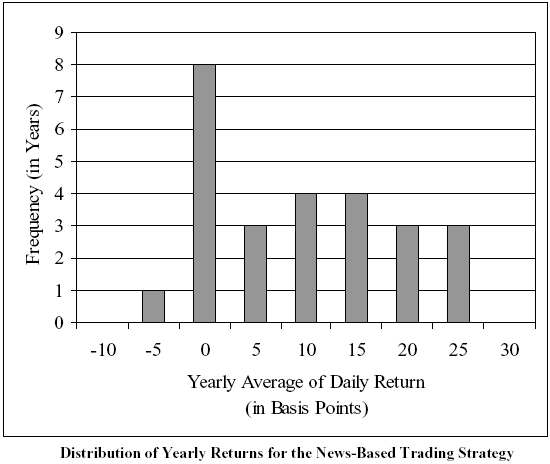Does exceptionally negative news coverage predict hard times for a company and its stock price? In their August 2006 paper entitled “More Than Words: Quantifying Language to Measure Firms’ Fundamentals”, Paul Tetlock, Maytal Saar-Tsechansky and Sofus Mackassy test whether they can predict a company’s future performance and stock returns by quantifying the sentiment in its financial news coverage. Their sentiment measure is a standardized level of negativity based on word counts and the Harvard psychosocial dictionary. Using Wall Street Journal (WSJ) and Dow Jones News Service (DJNS) stories about individual S&P 500 firms during 1980-2004 (350,000 significant articles), along with contemporaneous financial and stock price data, they find that:
- Company news articles cluster around earnings announcement dates.
- Abnormally negative pre-announcement news coverage predicts bad earnings surprises.
- Stock prices exhibit a delayed response to negative news sentiment on the next trading day. Trading strategies based on sentiment in a real-time news source (DJNS) are much more likely to be profitable than those based on a source offering day-old news (WSJ).
- Earnings and return predictability based on news sentiment is strongest for stories that focus on firm fundamentals (such as earnings).
- A portfolio that is long (short) stocks with positive (negative) DJNS stories during the preceding day, rebalanced at the close of each trading day, returns an annualized 21.1% before transaction costs (a median return of 10.2 basis points per day). This strategy earns positive excess returns in 18 out of 25 years (see chart below). However, reasonable transaction costs eliminate profitability.
The following chart, taken from the paper, shows the frequency of annual raw returns from the news sentiment trading strategy described above (excluding trading costs). Each entry on the horizontal axis represents a 5-basis point range around the nominal value. For example, the frequency for the 15-basis point entry is the number of years (four) for which the average daily return falls between 12.5 and 17.5 basis points.

In summary, media sentiment predicts small surprises in earnings and stock prices, which investors quickly incorporate into stock prices. However, transaction costs offset the surprise returns.
One interpretation of this result is that transaction costs represent the market’s price for incorporating the daily news.